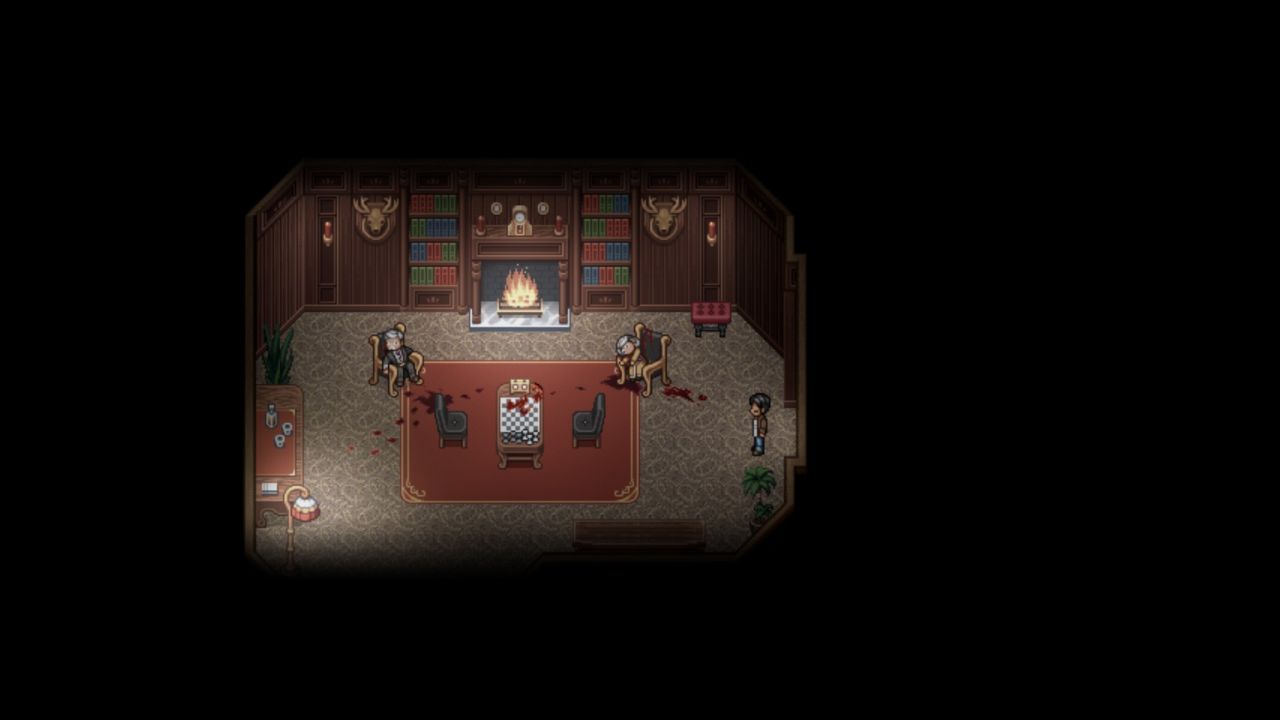
[ad_1]
Every good murder mystery needs a spooky house for a stage. That’s the rules. The one in Impostor Factory is a secluded manor deep in the woods, a crumbling temple to cleanliness with self-cleaning floors and a literal golden toilet in the bathroom. You are the first to arrive, shoulders heavy with rain. You don’t know much about the hosts, apart from the fact that they’re old, eccentric, and eager to unveil the mysterious machine looming in the main hall. The other guests are as rich and quirky as the villa’s owners, and you, an everyday man named Quincy, are starting to feel a bit awkward about the whole situation. And yet you stay because you’re curious about the machine, the weird vision you had in the bathroom, and that other guest you keep bumping into – the lady in a red dress that looks familiar and sad and full of secrets.
The stage is set. The guests are gathered. The murders begin. And then they happen again, and again, and again. The real mystery is not discovering who committed the murders. The mystery is understanding why they keep happening.
Impostor Factory is the third entry in the To The Moon saga, a series by developer Kan Gao about doctors wandering through their patients’ memories to give the story of their life a better ending. Think Eternal Sunshine Of The Spotless Mind, although here the technology developed by the fictional Sigmund Corp. can only be used on the dying. In To The Moon, for example, two scientists explored the memories of an elderly man to — guess what — help him fulfill his dream of going to the Moon. I still haven’t played the sequel, Finding Paradise, and you don’t need to play the prequels to piece together the story of Impostor Factory, but you might as well. Each game can be completed in a single sitting.
Despite being part of the To The Moon universe, the first hour of Impostor Factory reminded me of an earlier Gao game: the short, free, utterly incomprehensible horror The Mirror Lied. Similar setting, similar eeriness, similar sense of impending doom invading a homely environment. Impostor Factory, too, wants to fill you with uneasiness, and manages to do so without ever resorting to monsters or jump scares. There’s just you, a vast villa, and a crime that keeps repeating like a broken record. It’s an intriguing setup for a murder mystery, though there isn’t much to investigate: the plot unravels more like an interactive movie than a game, eschewing even the basic puzzles that dotted To The Moon to focus entirely on the story. You walk around, talk to people, follow an entirely linear narrative, and that’s it. Call it a walking simulator, if you must.

But what a compelling movie it is! It may be weird to call a 2D pixel art game “cinematic”, and yet there’s a certain cinematic flair in the way the script unravels, mixing with confidence humor and horror, delivering beats and twists with surgical grace. I really hope someone will give Gao a couple of millions of dollars and a camera at some point, because it’s clear this developer loves to tell visual stories, and it shines through every cutscene — despite the limited tools.
In case you’re wondering, yes, Gao’s engine of choice is still an old version of RPG Maker, which means choppy framerate and small, fixed resolution. The end result undoubtedly seems old-fashioned, though you can feel the care that went into each small animation of characters holding each other, hugging, smiling and crying.
It’s a real pity the game stops pretending to be a murder mystery after the first act, returning to more familar ground: memory-hopping, domestic tragedies, lost loves and sick children. It’s a sob story that manages to tread the line between heartfelt and saccharine, and which will either annoy you or make you cry depending on your tolerance for expert heartstring pulling. I thought myself immune to the trick, and yet ended up shedding a tear or two towards the end.

If you liked To The Moon, this game is exactly what you would expect from a sequel: a polished follow-up that never strays too far from its predecessor, delivering a bittersweet, heartwarming story that can be completed in a single afternoon. It will annoy some, make others happy, and others still wish to see Gao do more. And yet, I really can’t really say anything bad about this game. Perhaps it’s because I am fond of To The Moon’s cast of disaster scientists, and seeing them again is like seeing old friends. Perhaps it’s because, despite the slightly tired formula, Impostor Factory’s ideas still feel fresh.
With few exceptions (the Black Mirror episode San Junipero comes to mind), stories about imaginary worlds tend to be self-critical about the fantasy they want to conjure. Fleeing into a fantasy world is a form of escapism that needs to be condemned, even when the challenges of the fantasy world are no easier than reality. The Lost Boys of Peter Pan return to their home. The kids in Narnia go back into the wardrobe. The annoying hero of Final Fantasy Tactics Advance destroys the game’s setting to return to the real world. The fantasy can be tolerated only when it dares admit its self-indulgent nature, like in the isekai genre.
Impostor Factory is another of those rare exceptions: a game that cheerfully posits that a fake, imaginary life can be as fulfilling, precious and valid as a real one. And isn’t this why we all play videogames, after all?
[ad_2]





